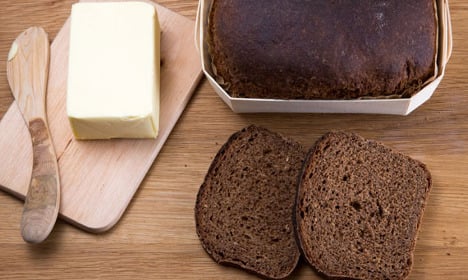Summary
Makes: 2 small loaves
Preparation: 20 minutes (plus three hours to prove)
Cooking: 35 minutes
Ingredients
120 g caster (superfine) sugar
420 g boiling water
1 tbsp spirit vinegar (5 percent)
340 g strong bread flour (all-purpose flour)
50 g strong wholemeal (whole wheat) bread flour
140 g rye flour
1 ½ tbsp vital gluten flour, optional
3 cocoa powder, sifted
1 tbsp fennel seeds
1 tbsp caraway seeds
1 tbsp soft dark brown sugar
1 ½ tsp salt
7 g fast action (easy bake) yeast, 1 packet
Method
1. Heat the sugar in a saucepan over a medium high heat, stirring regularly, until the sugar melts.
2. Turn down the heat and continue heating and stirring until the sugar is a deep caramel colour and is beginning to smoke slightly.
3. Remove from the heat, leave for five minutes and then add the boiling water. Return to a boil, stirring until all the sugar has dissolved.
4. Leave to cool to 40C and then measure out 440 g of sugar water. If you have too much, discard the rest. If you haven't got enough, add water to bring the total up to 440 g.
5. Add the vinegar to the sugar water and stir to mix.
6. Add the flours, cocoa powder, seeds, brown sugar and salt to the bowl of a stand mixer. Mix thoroughly with a spoon.
7. Add the yeast and mix thoroughly.
8. Fit the dough hook to the mixer and with the speed on minimum slowly add the sugar water and vinegar to the flour mixture.
9. Increase the speed to two or three for four minutes, by which time you should have a slightly sticky ball of dough.
10. Cover with cling film or a shower cap and leave in a draft-free warm place for about two hours until doubled in size.
11. Knock back on a floured work surface, divide in two and shape to fit two lightly oiled 500 g (1 lb) loaf tins. Gently cover with a floured cloth or lightly oiled cling film and leave for about 45 minutes to double in size again.
12. Preheat the oven, and bread dome if used, to 220C.
13. If using a dome, bake each loaf for 35 minutes, removing the dome for the last five minutes. If not using a dome, bake until the internal temperature of the breat is 95C, about 35 minutes.
14. If baked in a loaf tin, remove from the tin and leave to cool on a wire rack.
Tips
– If you have one, I recommend baking the bread in a bread dome or in an oblong covered baker, removing the cover for the last five minutes. Alternatively, you can use an overproof casserole dish.
– Don't worry if you can't cover the bread, it will simply have a more caramelized crust, which you might prefer anyway.
– If you are baking it without a dome, add a tray of boiling water to the bottom of the overn to prevent the bread from drying out.
This recipe, adapted from a recipe by Paul Moran (Canada's Young Chef of the Year 2014), was originally published on food writer John Duxbury's website Swedish Food.



 Please whitelist us to continue reading.
Please whitelist us to continue reading.